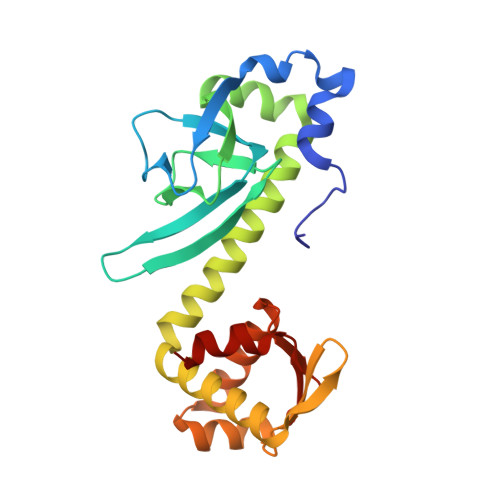Crystal Structure of CO-sensing Transcription Activator CooA Bound to Exogenous Ligand Imidazole
Komori, H., Inagaki, S., Yoshioka, S., Aono, S., Higuchi, Y.(2007) J Mol Biology 367: 864-871
- PubMed: 17292914
- DOI: https://doi.org/10.1016/j.jmb.2007.01.043
- Primary Citation of Related Structures:
2FMY - PubMed Abstract:
CooA is a CO-dependent transcriptional activator and transmits a CO-sensing signal to a DNA promoter that controls the expression of the genes responsible for CO metabolism. CooA contains a b-type heme as the active site for sensing CO. CO binding to the heme induces a conformational change that switches CooA from an inactive to an active DNA-binding form. Here, we report the crystal structure of an imidazole-bound form of CooA from Carboxydothermus hydrogenoformans (Ch-CooA). In the resting form, Ch-CooA has a six-coordinate ferrous heme with two endogenous axial ligands, the alpha-amino group of the N-terminal amino acid and a histidine residue. The N-terminal amino group of CooA that is coordinated to the heme iron is replaced by CO. This substitution presumably triggers a structural change leading to the active form. The crystal structure of Ch-CooA reveals that imidazole binds to the heme, which replaces the N terminus, as does CO. The dissociated N terminus is positioned approximately 16 A from the heme iron in the imidazole-bound form. In addition, the heme plane is rotated by 30 degrees about the normal of the porphyrin ring compared to that found in the inactive form of Rhodospirillum rubrum CooA. Even though the ligand exchange, imidazole-bound Ch-CooA remains in the inactive form for DNA binding. These results indicate that the release of the N terminus resulting from imidazole binding is not sufficient to activate CooA. The structure provides new insights into the structural changes required to achieve activation.
- Department of Life Science, Graduate School of Life Science, University of Hyogo and Himeji Institute of Technology, 3-2-1 Koto, Kamigori-cho, Ako-gun, Hyogo 678-1297, Japan.
Organizational Affiliation:


















